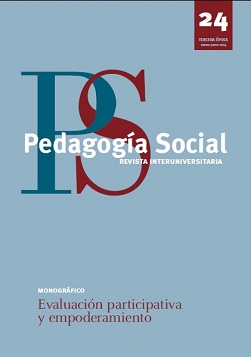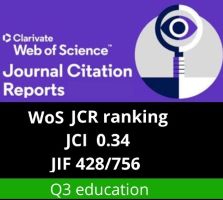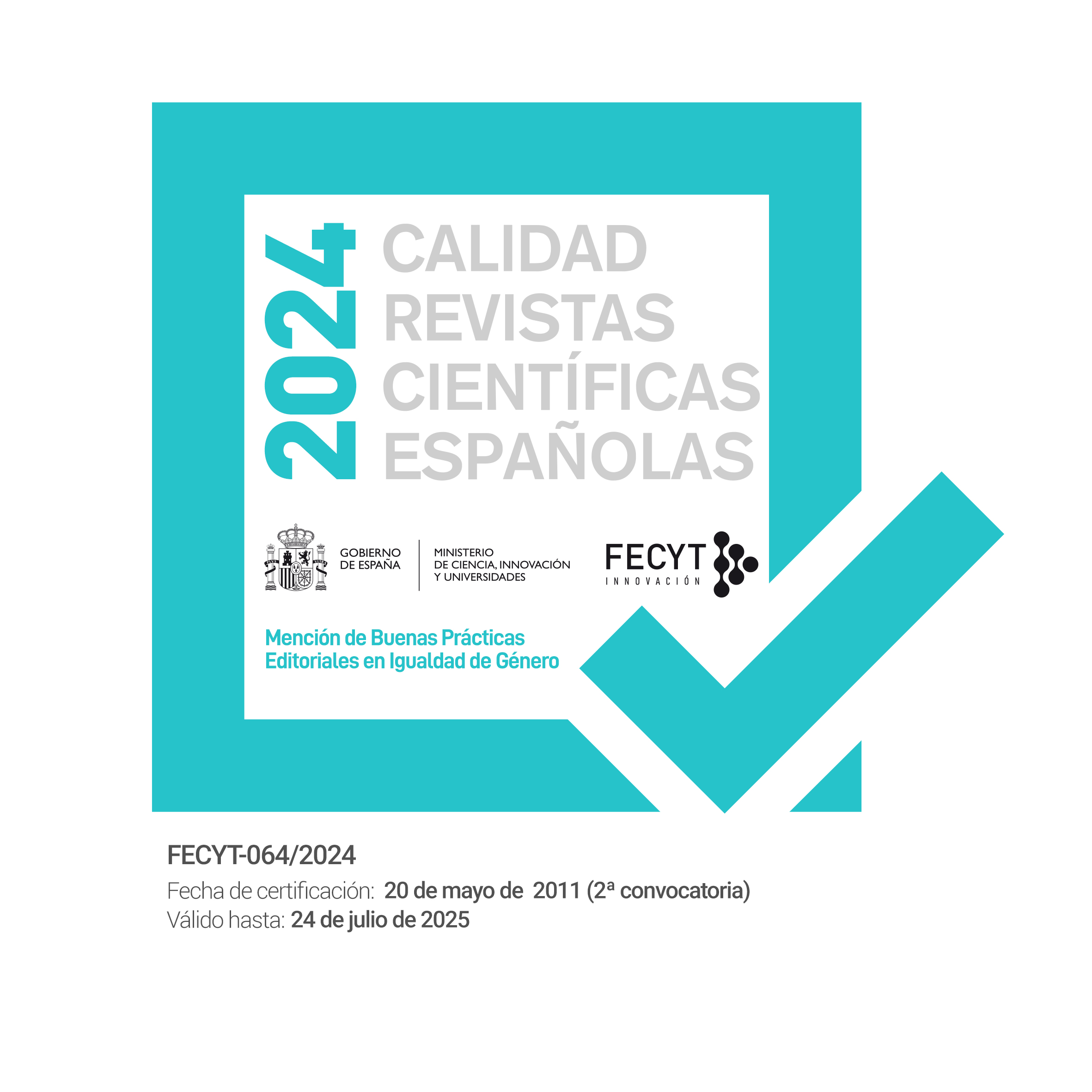Predictores de la actividad física de tiempo libre en una población universitaria española
DOI:
https://doi.org/10.7179/PSRI_2014.24.08Palabras clave:
Deporte, ocio, estudiantes adultos, personal académico docente, sexoResumen
Objetivos: determinar predictores del comportamiento físico-deportivo de tiempo libre de miembros de la comunidad universitaria española. Muestra: Participaron 1.340 universitarios (48% hombres), con una edad media de 22 años. Variables: práctica físico-deportiva de tiempo libre actual, sexo, estado civil, lugar de residencia, cantidad de tiempo libre en días laborables, fines de semana y días festivos, ocupación del tiempo libre; deseo de realizar actividad física, satisfacción con el uso del tiempo libre, práctica de actividad física de tiempo libre en el pasado, y años que llevan practicando actividad física. Método: Se realizaron entrevistas cara a cara mediante un cuestionario con preguntas cerradas. Resultados: El cincuenta y ocho por ciento de los sujetos declararon ser físicamente inactivos en la actualidad. El sexo masculino, el deseo de realizar actividad física, la satisfacción con el uso del tiempo libre, y la práctica de deportes en el pasado, se asociaron significativamente con la actividad físico-deportiva de tiempo libre. Conclusiones: La práctica física durante la niñez y la adolescencia es el predictor más fuerte de la actividad físico-deportiva en la población universitaria.
Descargas
Citas
Abarca-Sos, A., Zaragoza Casterad, J., Generelo Lanaspa, E. & Julián Clemente, J.A. (2010). Comportamientos sedentarios y patrones de actividad física en adolescentes. Revista Internacional de Medicina y Ciencias de la Actividad Física y el Deporte, 10(39), 410-427.
Ahmed, N. U., Smith, G. L., Flores, A. M., Pamies, R. J., Mason, H. R. C., Woods, K. F., & Stain, S. C. (2005). Racial/ethnic disparity and predictors of leisure-time physical activity among US men. Ethnicity & Disease, 15, 40-52.
Anton, S. D., Perri, M. G., Riley, J., Kanasky, W. F., Rodrigue, J. R., Sears, S. F., & Martin, A. D. (2005). Differential predictors of adherence in exercise programs with moderate versus higher levels of intensity and frequency. Journal of Sport & Exercise Psychology, 27(2), 171-187.
Arruza, J.A. y Arribas, S. (2008). La investigación de la actividad física y el deporte. Revista de Psicodidáctica, 13 (1), 111-131.
Azevedo, M. R., Araújo, C. L. P., Reichert, F. F., Siqueira, F. V., Da Silva, M. C., & Hallal, P. C. (2007). Gender differences in leisure-time physical activity. International journal of public health, 52(1), 8–15. doi:10.1007/s00038-006-5062-1
Blasco, T., Capdevila, L., Pintanel, M., Valiente, L. & Cruz, J. (1996). Evolución de los patrones de actividad física en estudiantes universitarios. Revista de Psicología del Deporte, 9(10), 51-63.
Cardon, G., Philippaerts, R., Lefevre, J., Matton, L., Wijndaele, K., Balduck, A.-L., & Bourdeaudhuij, I. D. (2005). Physical Activity Levels in 10- to 11-Year-Olds: Clustering of Psychosocial Correlates. Public Health Nutrition, 8(07), 896-903.
Castillo Viera, E. & Giménez Fuentes-Guerra, F.J. (2011). Hábitos de práctica de actividad física del alumnado de la Universidad de Huelva. Revista Internacional de Medicina y Ciencias de la Actividad Física y el Deporte, 11(41), 127-144.
Deforche, B. I., De Bourdeaudhuij, I. M. & Tanghe, A. P. (2006). Attitude toward physical activity in normalweight, overweight and obese adolescents. Journal of adolescent health, 38(5), 560–568.
Elizondo-Armendáriz, J. J., Guillén Grima, F. & Aguinaga Ontoso, I. (2005). Prevalencia de actividad física y su relación con variables sociodemográficas y estilos de vida en la población de 18 a 65 años de Pamplona. Revista Española de Salud Pública, 79(5), 559-567.
Fernández García, E., Sánchez Bañuelos, F. & Salinero Martín, J. J. (2008). Validación y adaptación de la escala PACES de disfrute con la práctica de la actividad física para adolescentes españolas. Psicothema, 20(4), 890-895.
García Bengoechea, E., Spence, J. C. & McGannon, K. R. (2005). Gender differences in perceived environmental correlates of physical activity. International Journal of Behavioral Nutrition and Physical Activity, 2(12).
Gómez-López, M., Granero Gallegos, A. & Baena Extremera, A. (2010). Perceived barriers by university students in the practice of physical activities. Journal of Sports Science and Medicine, 9(3), 374–381.
De Gracia, M. & Marcó, M. (2000). Efectos psicológicos de la actividad física en personas mayores. Psicothema, 12 (2), 285–292.
Inchley, J. C., Currie, D. B., Todd, J. M., Akhtar, P. C. & Currie, C. E. (2005). Persistent socio-demographic differences in physical activity among Scottish schoolchildren 1990–2002. The European Journal of Public Health, 15(4), 386 -388.
Kafatos, A., Manios, Y., Markatji, I., Giachetti, I., Vaz de Almeida, M. D. & Engstrom, L. M. (1999). Regional, Demographic and National Influences on Attitudes and Beliefs with Regard to Physical Activity, Body Weight and Health in a Nationally representative Sample in the European Union. Public Health Nutrition, 2 (Supplement 1a), 87-96.
Kaplan, M. S., Newsom, J. T., McFarland, B. H. & Lu, L. (2001). Demographic and psychosocial correlates of physical activity in late life. American Journal of Preventive Medicine, 21(4), 306-312.
Kuh, D. J. & Cooper, C. (1992). Physical activity at 36 years: patterns and childhood predictors in a longitudinal study. Journal of Epidemiology and Community Health, 46(2), 114 -119.
Lee, Y.-S. (2005). Gender Differences in Physical Activity and Walking Among Older Adults. Journal of Women & Aging, 17(1), 55-70.
Orepic, P., Mikulic, P., Soric, M., Ruzic, L. & Markovic, G. (2014). Acute physiological responses to recreational in-line skating in young adults. European Journal Of Sport Science, 14, 25-31. doi:10.1080/17461391.2011.638936
Pavón Lores, A. & Moreno Murcia, J.A. (2008). Actitud de los universitarios ante la práctica físico-deportiva: diferencias por géneros. Revista de Psicología del Deporte, 17(1), 7-23.
Pitsavos, C., Panagiotakos, D., Lentzas, Y. & Stefanadis, C. (2005). Epidemiology of leisure-time physical activity in socio-demographic, lifestyle and psychological characteristics of men and women in Greece: the ATTICA Study. BMC Public Health, 5(1), 37.
Prochaska, J. O. & Velicer, W. F. (1997). The transtheoretical model of health behavior change. American journal of health promotion: AJHP, 12(1), 38-48.
Reichert, F. F., Barros, A. J. D., Domingues, M. R. & Hallal, P. C. (2007). The role of perceived personal barriers to engagement in leisure-time physical activity. American journal of public health, 97(3), 515-519.
Sacker, A. & Cable, N. (2006). Do adolescent leisure-time physical activities foster health and well-being in adulthood? Evidence from two British birth cohorts. The European Journal of Public Health, 16(3), 332-336.
Sallis, J. F., Prochaska, J. J. & Taylor, W. C. (2000). A review of correlates of physical activity of children and adolescents. Medicine & Science in Sports & Exercise, 32(5), 963-975.
Santos, M. P., Gomes, H. & Mota, J. (2005). Physical activity and sedentary behaviors in adolescents. Annals of Behavioral Medicine, 30(1), 21-24.
Schneider, S. & Becker, S. (2005). Prevalence of Physical Activity among the Working Population and Correlation with Work-Related Factors: Results from the First German National Health Survey. Journal of Occupational Health, 47(5), 414-423.
Serra Puyal, J.R., Generelo Lanaspa, E. & Zaragoza Casterad, J. (2011). Estados de cambio y su relación con los niveles de actividad física en población adolescente. Revista Internacional de Medicina y Ciencias de la Actividad Física y el Deporte, 11(42), 298-309.
Sharma, M., Sargent, L. & Stacy, R. (2005). Predictors of Leisure-time Physical Activity Among African American Women. American Journal of Health Behavior, 29(4), 352-359.
Telama, R., Yang, X., Viikari, J., Välimäki, I., Wanne, O. & Raitakari, O. (2005). Physical activity from childhood to adulthood: A 21-year tracking study. American Journal of Preventive Medicine, 28(3), 267-273.
Telford, A., Salmon, J., Timperio, A. & Crawford, D. (2005). Examining physical activity among 5- to 6- and 10- to 12-year-old children: The Children’s Leisure Activities Study. Pediatric Exercise Science, 17(3), 266-280.
Trost, S. G., Owen, N., Bauman, A. E., Sallis, J. F. & Brown, W. (2002). Correlates of adults’ participation in physical activity: review and update. Medicine & Science in Sports & Exercise, 34(12), 1996-2001.
Vagetti, G.C., Barbosa, V.C., Moreira, N.B., de Oliveira, V., Mazzardo, O. & de Campos, W. (2014). Association between physical activity and quality of life in the elderly: a systematic review, 2000-2012. Revista Brasileira de Psiquiatria, 36(1), 76-88. doi:10.1590/1516-4446-2012-0895
Vaz, M. & Bhorathi, A. V. (2003). An exploratory study of perceptions and practices related to physical activity in women college teachers and students in Bangalore, South India. Health Education Journal, 62(4),316 -325.
Warburton, D. E. R., Nicol, C. W. & Bredin, S. S. D. (2006). Health benefits of physical activity: the evidence. CMAJ, 174(6), 801-809.
Westerståhl, M., Barnekow-Bergkvist, M. & Jansson, E. (2005). Low physical activity among adolescents in practical education. Scandinavian Journal of Medicine & Science in Sports, 15(5), 287-297
Descargas
Publicado
Cómo citar
Número
Sección
Licencia
Derechos de autor 2014 Pedagogía social. Revista interuniversitaria

Esta obra está bajo una licencia Creative Commons Reconocimiento-NoComercial 3.0 Unported.
Derechos de reproducción y archivo
La versión publicada de los artículos podrá ser autoarchivada por sus autores en repositorios institucionales y temáticos de acceso abierto. No obstante la reutilización total o parcial de los mismos en nuevos trabajos o publicaciones deberá ser autorizada por Pedagogía Social. Revista Interuniversitaria.
Los trabajos publicados deberán ser citados incluyendo el título de la Revista, Pedagogía Social. Revista Interuniversitaria, nº, páginas y año de publicación.
Responsabilidades éticas
Pedagogía Social. Revista Interuniversitaria no acepta material publicado anteriormente en otros documentos. Los/as autores/as son responsables de obtener los permisos oportunos para reproducir parcialmente material de otras publicaciones y citar correctamente su procedencia. Estos permisos deben solicitarse tanto al autor/a como a la editorial que ha publicado dicho material.
Es obligación de Pedagogía Social. Revista Interuniversitaria detectar y denunciar prácticas fraudulentas.
En la lista de autores/as firmantes deben figurar únicamente aquellas personas que han contribuido intelectualmente al desarrollo del trabajo.
La revista espera que los/as autores/as declaren cualquier asociación comercial que pueda suponer un conflicto de intereses en conexión con el artículo remitido.
Los autores deben mencionar en el manuscrito, preferentemente en el apartado del método, que los procedimientos utilizados en los muestreos y controles han sido realizados tras la obtención de consentimiento informado.
La revista no utilizará ninguno de los trabajos recibidos con otro fin que no sea el de los objetivos descritos en estas normas.
Aviso de derechos de autor/a
© Pedagogía Social. Revista Interuniversitaria. Los originales publicados en las ediciones impresa y electrónica de esta Revista son propiedad del Pedagogía Social. Revista Interuniversitaria, siendo necesario citar la procedencia en cualquier reproducción parcial o total.
Salvo indicación contraria, todos los contenidos de la edición electrónica se distribuyen bajo una licencia de uso y distribución “Creative Commons Reconocimiento-No Comercial 3.0 España” (CC-by-nc). Puede consultar desde aquí la versión informativa y el texto legal de la licencia. Esta circunstancia ha de hacerse constar expresamente de esta forma cuando sea necesario.






